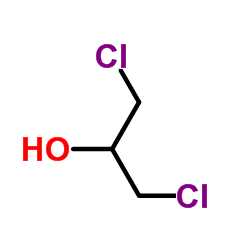1,3-二氯丙醇
一般危化品

1,3-二氯丙醇结构式
|
常用名 | 1,3-二氯丙醇 | 英文名 | 1,3-Dichloro-2-propanol |
|---|---|---|---|---|
| CAS号 | 96-23-1 | 分子量 | 128.985 | |
| 密度 | 1.3±0.1 g/cm3 | 沸点 | 174.3±0.0 °C at 760 mmHg | |
| 分子式 | C3H6Cl2O | 熔点 | -4 °C | |
| MSDS | 中文版 美版 | 闪点 | 85.6±0.0 °C | |
| 符号 |


GHS06, GHS08 |
信号词 | Danger |
|
Mechanism of chemical activation of sodium chloride in the presence of amino acids.
Food Chem. 166 , 301-8, (2014) Sodium chloride has been shown to promote chlorination of glycerol during thermal processing. However, the detailed mechanism of this reaction is not well understood. Preliminary experiments have indicated that the reaction mixture should contain an amino aci... |
|
|
Exploring the enantioselective mechanism of halohydrin dehalogenase from Agrobacterium radiobacter AD1 by iterative saturation mutagenesis.
Appl. Environ. Microbiol. 81(8) , 2919-26, (2015) Halohydrin dehalogenase from Agrobacterium radiobacter AD1 (HheC) shows great potential in producing valuable chiral epoxides and β-substituted alcohols. The wild-type (WT) enzyme displays a high R-enantiopreference toward most aromatic substrates, whereas no... |
|
|
Halogenated derivatives QSAR model using spectral moments to predict haloacetic acids (HAA) mutagenicity.
Bioorg. Med. Chem. 16 , 5720-32, (2008) The risk of the presence of haloacetic acids in drinking water as chlorination by-products and the shortage of experimental mutagenicity data for most of them requires a research work. This paper describes a QSAR model to predict direct mutagenicity for these... |
|
|
Complete detoxification of tris(1,3-dichloro-2-propyl) phosphate by mixed two bacteria, Sphingobium sp. strain TCM1 and Arthrobacter sp. strain PY1.
J. Biosci. Bioeng. 113(1) , 79-83, (2012) Tris(1,3-dichloro-2-propyl) phosphate (TDCPP), a flame retardant, is regarded as a potentially toxic and persistent environmental contaminant. We previously isolated a TDCPP-degrading bacterium, Sphingobium sp. strain TCM1, which, however, produced a toxic me... |
|
|
Passage of MHPG from plasma to CSF in a non-human primate.
Rev. Med. Chir. Soc. Med. Nat. Iasi. 115(4) , 1278-82, (2011) In experimental protocols with humans and non-human primates, cerebrospinal fluid (CSF) concentrations of 3-methoxy-4-hydroxyphenylethylene glycol (MHPG), the predominant end-product of norepinephrine metabolism in the mammalian central nervous system (CNS), ... |
|
|
An enzymatic method for determination of azide and cyanide in aqueous phase.
J. Biotechnol. 214 , 27-32, (2015) A halohydrin dehalogenase (HHDH-PL) from Parvibaculum lavamentivorans DS-1 was characterized and applied to determine azide and cyanide in the water. In this methodology, HHDH-PL catalysed azide and cyanide to react with butylene oxide and form corresponding ... |
|
|
The simultaneous separation and determination of chloropropanols in soy sauce and other flavoring with gas chromatography-mass spectrometry in negative chemical and electron impact ionization modes.
Food Addit. Contam. 23(2) , 110-9, (2006) Both gas chromatography-mass spectrometry in electron ionization (GC-MS-EI) and negative chemical ionization (GC-MS-NCI) modes are reported in this paper for the simultaneous determination of 1,3-dichloropropan-2-ol (1,3-DCP), 2,3-dichloropropan-1-ol (2,3-DCP... |
|
|
An evaluation of the chick cardiomyocyte micromass system for identification of teratogens in a blind trial
Reprod. Toxicol. 28(4) , 503-10, (2009) The chick micromass culture system has advantages over the validated rat system – ready availability and non-culling of the donor parent – but needs to give comparable results. This study confirmed comparability and the ability to extend the system to cover c... |
|
|
1,3-Dichloro-2-propanol inhibits progesterone production through the expression of steroidogenic enzymes and cAMP concentration in Leydig cells.
Food Chem. 154 , 330-6, (2014) 1,3-Dichloro-2-propanol (1,3-DCP) is a well-known food processing contaminant that has been shown to impede male reproductive function. However, its mechanism of action remains elusive. In this study, the effects of 1,3-DCP on progesterone production were inv... |
|
|
Developmental toxic potential of 1,3-dichloro-2-propanol in Sprague–Dawley rats
Regul Toxicol Pharmacol 53(1) , 63-9, (2009) This study investigated the potential adverse effects of 1,3-dichloro-2-propanol (1,3-DCP) on pregnant dams and the embryo-fetal development after maternal exposure on gestational days (GD) 6 through 19 in Sprague–Dawley rats. The test chemical was administer... |